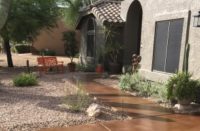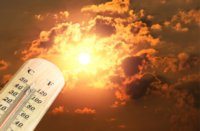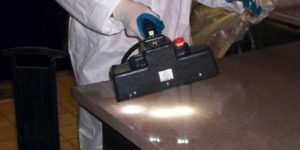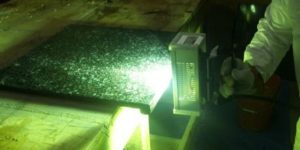
Like all serious concrete countertop artisans, Chris Klipfel has spent years searching for the ideal material to seal his work. With UV-cured coatings, clear coatings that cure with controlled exposure to ultraviolet (UV) light, he thinks he is pretty close. “Some of the UV-cured coatings are the most stain-resistant of any sealer on the market,” says Klipfel, owner of CK Concrete Design, St. Louis, Mo. “Even against crazy stuff, like muriatic acid.”
This makes UV-cured coatings great for the harsh environment of a family kitchen. “Nothing you can buy at the grocery store will hurt it,” says Kevin Ormsby, vice president of sales and marketing for Kinloch USA.
Klipfel likes UV-cured coatings for exterior jobs too, because, he says, they’re “the best thing out there” to resist damage from sun or water. “The only sealer I know for sure will never break down with five days of water sitting on it is a UV coating.”
Another advantage of UV-cured coatings is appearance. Bill Kulish, owner and artisan at Quintechs LLC, a concrete countertop, art and design company in Wilmington, Del., likes them because they leave only a thin film – “thinner than a piece of paper,” he says – and can be honed to a matte finish that looks like no coating is there at all.
This protection is long-lasting too. “UV-cured coatings will outlast a traditional sealer and preserve your work for much, much longer,” according to Harry Crum, business development coordinator for Kemiko Decorative and Industrial Coatings.
With curing equipment designed for concrete countertops as well as concrete floors, UV-cured coatings are typically waterborne or 100 percent solids, so there are no volatile organic compounds (VOCs), no solvents to flash off or outgas. This makes them a good choice – sometimes the only choice – for applications affected by tight environmental or health department regulations.
Most UV-cured coatings are easy to apply, and contractors can reduce their learning curve by taking advantage of suppliers’ training. One hundred percent solids coatings can be cured immediately. Waterborne coatings need to sit for anywhere from 30 minutes to two hours, depending on conditions and manufacturers’ instructions, for the water to flash off. Either type of coating can be left uncured for hours or even overnight, but both only reach full hardness and chemical resistance after curing.
The single most important advantage of UV-cured coatings is speed. “The sealer cures completely in seconds and can be returned to service immediately,” according to Bill York, senior technical advisor for V-Seal Concrete Sealers. An entire factory floor can be sealed over the weekend and be in full service Monday. A restaurant can close at midnight and be open for brunch the next morning. A contractor can seal and deliver a countertop in the same day. A homeowner can drive his car back into the garage as soon as the contractor leaves.
“UV-cured coatings in general are just more robust than conventional two-part coatings,” says Charlie Foster, chemist at Kinloch USA. Klipfel, for his part, feels his work is protected by a coating that is as close to indestructible as it can be.

The process and the finish
However, along with its benefits, UV-cure technology poses unique challenges for contractors. They must deal with the curing process, and they need to wrestle with the possibility of a glossy finish.
When Klipfel is asked what he likes best about UV-cured coatings, he says, “peace of mind – but then I lose my mind when I have to finish it.”
UV-cure chemistry is straightforward: Photoinitiators are activated by UV exposure and the material cures immediately. The 100 percent solids coating Klipfel uses requires a “partial cure” to avoid shrinking. This requires multiple passes at different intensities, a process Klipfel says is tedious with his countertop-curing equipment. Even if partial cure is not required, most suppliers recommend curing the coating in two passes, the second at a 90-degree angle from the direction of the first, to assure full exposure.
Contractors who want a honed finish typically apply two coats to get a coating thick enough to sand, according to Foster. A second coat also fills in any pinholes or micropores left in the first coat. “A micropore is shaped like a volcano,” Foster says. “It’s smaller at the top than at the bottom, so if it is not filled, stain agents can get through the coating and damage the concrete below.”

Which brings us to the second challenge – finishing. Many contractors find UV-cured coatings too glossy to impart a natural look. While there are matte-finish UV-cured coatings on the market, some applicators feel the materials added to the coating to knock down the gloss also impair clarity, so they prefer sanding themselves. Some contractors report sanding even the matte finishes.
Sanding requires more know-how than you might think. “You need skill in polishing if you’re going to meticulously sand the coating to achieve a matte finish,” Kulish says. What’s more, it can be time-consuming. Specialty pads and equipment such as an orbital sander can make the job go faster, but even so, Klipfel says he spends three or four hours sanding the average kitchen installation.
A new UV-curable coating introduced in July is one example of a coating that addresses the gloss issue. RockTop UV from Surface 519 can be buffed to a matte finish before it is cured. According to the manufacturer, the waterborne coating should be left uncured until it feels dry to the touch, then rubbed with a gray scrubbing pad by hand or with a sander to the desired sheen. Bob Chatterton of Surface 519 says it takes about 10 minutes to buff about 50 square feet. Then the coating is cured and the process repeated for a second coat. This product allows the contractor to see exactly what the finished coating will look like before it is cured. In fact, Chatterton warns, “Make sure it’s perfect before you cure it. Once it’s cured it is very difficult to go back and sand it because it is so hard and scratch-resistant.”
Cost is another hurdle for contractors considering UV-cured coatings.
The material cost is on the high end – between 70 cents and $1 per square foot. The application can determine which price point is appropriate. “In a garage, you’ll want to use a 100 percent solids materials for a quick in and out,” explains Michael Kelly, CEO of Allied PhotoChemical Inc. “A large floor might be more price-sensitive, so you might choose a water-based coating.”
But the biggest cost is the initial investment in the curing equipment. Good hand-held lamps, powerful enough to drive the light all the way through the coating, typically cost more than $2,000, though one recent entry to the market is priced below $1,000. Equipment for curing floor coatings is even more costly, ranging from $10,000 to $27,000.
So how does a contractor decide if the investment is worth it? Chatterton recommends you ask yourself the following questions: How many jobs do I do? What do I spend on callbacks? How many jobs can I get because I have this equipment? Kelly emphasizes the value of a quick cure. “You have instant use of your product, which means more money in your pocket,” he says.
Many suppliers lease or rent curing equipment. York recommends this option for first-time users. “It’s reasonable to buy the lamp by their second or third job, when they’ve proven there is significant financial advantage,” he says. “If you can get a premium price per square foot for finishing early, you’ve bought the lamp.”
Whether you buy, rent or lease, one very important consideration to note when choosing curing equipment is compatibility with your coating. Some suppliers sell the coating and the cure equipment as a package. Others publish technical specifications for curing requirements that a UV light supplier specializing in concrete coatings must meet.
In the end, does the peace of mind of using UV-cured coatings outweigh the maddening details? A hard, long-lasting, nearly invisible coating that resists scratching, staining and etching certainly delivers peace of mind for owners. And as coating and curing technologies advance, the challenges that can bother contractors are diminishing.
Equipment suppliers:
www.cureUV.com (SPDI UV)
www.jelight.com
www.uvcurenow.com (Adastra Technologies Inc.)
Coating suppliers
www.alliedphotochemical.com
www.kinlochusa.com
www.surface519.com
www.rapidshield.com
www.vseal.com















